Dr Joshi Hini AM.D. (Hom)
Dr NavinPawaskarM.D. (Hom), MICR (BOM), MHA (USA), CPDM (USA).
JIMS Homoeopathic Medical College and Hospital.
Reprinted with permission from the Indian Journal of Applied Homoeopathy where it first appeared. https://www.jimshomeocollege.com/ijah-publications/
Brief Review of Malaria Introduction:
Malaria is an ancient disease with references occurring in a Chinese document from about 2700 BC, clay tablets from Mesopotamia from 2000 BC, Egyptian papyri from 1570 BC and ancient Indian literature like Atharvaveda and CharakSamhita. The term ‘Malaria’ is derived from the Italian term “mal” or bad and “aria” or air. Malaria is a mosquito borne infectious disease. The first evidence of malaria (Homeopathy for Malaria) parasites was found in mosquitoes preserved in amber from the Palaeogene period that are approximately 30 million years old. Malaria since ancient times has caused a significant morbidity and mortality of the human race. Attempts to control and eradicate malaria are still under process. Every year 23rd April is commemorated as WORLD MALARIA DAY with a goal to provide education and understanding of malaria and spread information regarding implementation of strategies for prevention and control of malaria.
Causative organism:
Malaria is caused by infection with the protozoan of the Plasmodium species. Four species of Plasmodium can produce the disease in its various forms:
- Plasmodium Falciparum
- Plasmodium Vivax
- Plasmodium Ovale
- Plasmodium Malariae
Epidemiology:
Malaria is endemic in most of the tropical countries. About 95 countries across world have ongoing transmission. In the year 2015 about 214 million symptomatic cases were reported worldwide. Out of these about 80% were reported in African countries and about 13% in South East Asian Countries. The incidence of malaria in India accounts for 58% of cases in the South East Asia Region of WHO. The states of Orissa, Chhattisgarh, West Bengal, Jharkhand and Karnataka contribute the most malaria cases in India.
Transmission:
In humans, malaria is transmitted only by bites of females of the genus Anopheles. Other rare mechanisms of transmission are congenital transmission, through blood transfusion, sharing of contaminated needles & organ transplantation.
Habitat:
Anopheles breed in stagnant pools of water.
Life cycle:
The malaria parasite life cycle involves two hosts: Mosquito and Humans. In humans, the parasites grow and multiply first in the liver cells and then in the red cells of the blood. In the blood, successive broods of parasites grow inside the red cells and destroy them, releasing daughter parasites (“merozoites”) that continue the cycle by invading other red cells. The blood stage parasites are those that cause the symptoms of malaria. When certain forms of blood stage parasites (“gametocytes”) are picked up by a female Anopheles mosquito during a blood meal, they start another, different cycle of growth and multiplication in the mosquito. After 10-18 days, the parasites are found (as “sporozoites”) in the mosquito’s salivary glands. When the Anopheles mosquito takes a blood meal on another human, the sporozoites are injected with the mosquito’s saliva and start another human infection when they parasitize the liver cells.
Signs & Symptoms:
- Classic paroxysm begins with a period of shivering and chills which is followed by high fever and excessive diaphoresis.
- Period of apyrexia
- This classic paroxysm may be absent in some and they may present with any of one prominent stage such as chill, heat or sweat.
- Prodromal flu like illness with headache, arthralgia, myalgia, malaise.
- Hepatomegaly, Splenomegaly, Anaemia and low Platelet count.
Key differentiating points:
| Plasmodium Falciparum | Plasmodium Vivax | Plasmodium Ovale | Plasmodium Malariae | |
| Worldwide Incidence | 50% | 43% | Rarely encountered | 7% |
| Distribution | Tropics & sub tropics | Tropics & sub tropics | Tropical Africa | – |
| Incubation period | 9 – 14 days | 12 – 18 days | 12 – 18 days | 18 – 40 days |
| Periodicity of fever | Usually 48 hours but Irregular fever spikes present | 48 hours | 48 hours | 72 hours |
| Relapse | No | Yes | Yes | No |
| Complications | Usually fatal complications like Cerebral malaria, coma,
seizures, pulmonary oedema, renal failure, severe anaemia, black water fever |
Splenic rupture, hepatomegaly and hepatitis with or without jaundice, thrombocytopenia, acute respiratory distress syndrome, anaemia | Rare
Usually non- fatal |
Glomerulonephritis,
Nephrotic syndrome |
Diagnosis:
Diagnosis of malaria is made by demonstrating the parasite in the blood film or by detection of the malaria parasite antigen in the blood sample.
Control measures:
- Prevention of mosquitoes from biting
- Control of mosquito breeding places
- Killing of adult mosquitoes
Treatment:
Conventional treatment of malaria involves use of anti- malarial drugs.
GUIDELINES FOR HOMEOPATHIC MANAGEMENT
In the 6th edition of Organon of Medicine, Dr Hahnemann has set clear guidelines for management of intermittent fevers from aphorisms235 – 244.
Aphorism 233 states that intermittent fevers are a type of intermittent diseases. Intermittent fevers are fevers in which a morbid state of unvarying character returns at a tolerably fixed period and departs at an equally fixed period.
Aphorism 235 states that the remedy for the patient with fever should be selected on the basis of similarity of symptoms of the medicine obtained during proving to that of the presentation of the fever state as a whole. The accessory symptoms along with the heat, chill and sweat state and patient’s symptoms during apyrexia must be the chief guide for selection of the suitable homeopathic remedy.
Aphorism 236 emphasises the most efficacious time of administration of the remedy which is immediately or very soon after the termination of the paroxysm i.e. when the apyrexia has commenced.
Aphorism 237 states that if the stage of apyrexia is very short then the remedy should be administered when the perspiration begins to abate or when the fever paroxysm is in the declining phase.
Aphorism 238 emphasises the importance of a single dose of remedy which helps to curb further fever paroxysm in many cases but usually repetition of doses may be required if the same state recurrs.
Aphorism 243 states that in pernicious intermittent fevers, if recovery is deferred in spite of the employment of best selected simillimum, a deep acting anti-psoric may help to accomplish the cure.
HOMEOPATHIC APPROACH:
Through the cases discussed below we can study the various approaches in managing cases of malaria based on the clinical presentation:
CASE 1
A 28 years old male patient was admitted to the hospital with the complaints of fever with chills followed by sweating for the, past 6 days. Chills were ascending in nature beginning at 10 am followed by high grade fever from 12 to 1 pm. During fever he feels thirsty and drinks frequently about half a glass of water at a time. He also experiences throbbing headache with nausea, vomiting and bitter taste in mouth and generalised body ache with desire to stretch. After fever there is sweating all over the body at around 5 pm. Perspiration ameliorates chill and heat stages but his headache still persists.
| Case Analysis | ||||
| Prodrome | | | No symptoms | |
| Chill | | Character | | Chill 3 begins in soles of feet then spreads to the whole body, ascending |
| | Time | | 10 am | |
| | Ailments from | | – | |
| | Aggravation | | – | |
| | Amelioration | | Sweat ameliorates chill | |
| | Concomitants | | – | |
| Heat | | Character | | Heat sensation all over body |
| | Time | | 12 – 1 pm | |
| | Ailments from | | – | |
| | Aggravation | | Sweat ameliorates heat | |
| | Amelioration | | By sweating | |
| | Concomitants : Generals | | Thirst increased3, half glass frequently; body ache 3 with desire to stretch | |
| | Concomitants:
particular |
| Headache 3 as fever increases and decreases, throbbing type of pain; vomits whatever is eaten within 2-3 min of eating; nausea; bitter taste3 in mouth | |
| Perspiration | | Character | | All over the body |
| | Time | | 5 pm | |
| | Ailments from | | – | |
| | Aggravation | | – | |
| | Amelioration | | Perspiration ameliorates chill & heat except headache | |
| | Concomitants | | – | |
| Stage of Apyrexia | | Generals | | – |
| | Particular | | Headache | |
Evaluation of symptoms:
| No | Symptom | Classification of symptom |
| 1 | Fever alternate day at exact time | Characteristic type of fever |
| 2 | Chill at 10 am | Characteristic Aggravating time modality |
| 3 | Fever from 12 to 1 pm | Characteristic Aggravating time modality |
| 4 | Sweat at 5 pm | Characteristic Aggravating time modality |
| 5 | Sweat ameliorates all complaints except headache | Characteristic ameliorating modality |
| 6 | Chill ascending | Characteristic direction of chill |
| 7 | Headache apyrexia during | Characteristic Physical particular Concomitant |
| 8 | Thirst increased 3, half glass frequently | Characteristic Physical general Concomitant |
| 9 | Body ache fever with | Characteristic Physical general Concomitant |
| 10 | Desire to stretch body fever with | Characteristic Physical general Concomitant |
| 11 | Headache fever with | Characteristic Physical particular Concomitant |
| 12 | Vomiting fever with | Characteristic Physical particular Concomitant |
| 13 | Bitter taste fever with | Characteristic Physical particular Concomitant |
Eupatorium Perfoliatum
- Thirst followed by nausea and then shaking chills
- Chill: begins in the small of the back,
- Periodicity 7-9 am, double periodicity of chill
- Thirst for cold water
- Bitter vomiting after chill which relives
- Heat: high grade burning heat with aching
- Aching in bones with soreness of muscles, sensation as if every bone in the body is broken
- Sweat: scanty sweat relives all the symptoms except headache
Chinchona Officinalis
- Prodromal : nervous excitement, anxiety, headache, nausea, irritability
- Chill: Chill followed by thirst, wants to wrap himself warmly, chill begins in the breast.
- Heat: without thirst, fiery red face with congestion of head, other parts chilly
- Sweat: with thirst, drenching profuse, debilitating
- Apyrexia: debility, restlessness, anaemia, oedema
- Sallow yellow complexion, anaemic& enlarged spleen
Nux vomica
- Malaria with prominent gastro-bilious symptoms
- Chill: preceded or accompanied by blueness of fingernails
- Chill with yawning & aching in limbs and back
- Chill not relieved by covering or external heat
- Thirstless
Natrum Muriaticum
- Useful in inveterate and badly treated cases, chronic malaria
- Chill: 10 – 11 am, begins in small of back or feet
- Chill with thirst and generalised aches and pains
- Heat: high fever with throbbing headache, increased thirst,
- Fever blisters around lips
- Sweat: debilitating, relieves all symptoms except headache.
- Yellowish grey complexion with enlarged liver & spleen
Remedy response:
Natrum Muriaticum 200 single dose was administered during the phase of apyrexia which abated the fever completely.
Discussion:
Dr H.C.Allen states that a remedy selected on the basis of clearly indicated fever totality aborts the current fever episode. To understand homoeopathic characteristics in intermittent fevers, attention should be paid to the following:
- Study the patient during the apyrexia, to form an exact idea of the functional action, regular or otherwise, of all the organs.
- Observe all the symptoms of the pyrexia in its three stages of cold, heat and sweat.
- Particularly note if a stage is absent, and/or which among them is the most marked.
- Expressly depend upon the bizarre, singular, exceptional, phenomena, because they, above all, are characteristic, and figure in the first rank of the symptoms to which the drug must correspond in order to cure”
In this case patient exhibited very minimal deviation from the original state of health though suffering from malaria, indicating good susceptibility. Patient’s ability to react to the malarial insult (stimulus) has to be robust for good number of characteristics to be seen in each stage of fever. This typically happens in young patients in first episode of malaria or when susceptibility is unaltered by other medicinal interventions.
CASE 2
A 40 year old female presents with complaints of sudden onset of fever with chill & loose motions for 1 day. Chill began at 11 am and was followed by fever. Fever lasted from 11 am to 4 pm. There was associated headache and body ache during chill and heat. Perspiration began at 4 pm and was profuse, cold and clammy. Sweating relieved her fever. She has loose watery stools with pain in epigastrium & left hypochondria. Her appetite is decreased and there is a bitter taste in her mouth.
| Chill | Started since 11 am, associated with headache and body ache |
| Heat | High grade fever,from 11 am till 4 pm, associated with headache and body ache |
| Sweat | Began at 4 pm, Profuse cold and clammy, Relieved fever |
| Loose stools | Dull pain, mild intensity pain in epigastrium and left hypochondria |
| Appetite | Decreased |
| Thirst | Normal, bitter taste in mouth |
| Extremities | Cold to touch |
| Habit | Habit of consuming alcohol for last 4 to 5 years |
Past history: H/o similar presentation before 1 year with pedal oedema which was diagnosed as Malaria
Examination findings:
Toxic look, Temperature- 101.2 oF, Pulse rate- 100/min, Respiratory Rate- 32/min, Pallor +
Examination of Respiratory, Cardiovascular and Central Nervous system was normal Per abdomen- Liver 1 finger palpable, Spleen not palpable
Investigations:
Haemoglobin 10.4, Total Leucocyte Count 9200, Neutrophils 73, Eosinophils 2, Lymphocytes 23, Monocytes 2, ESR 5
Peripheral Smear: Showed haemolysis. Malaria parasite negative
SGOT 173.2, SGPT 62.5, Total Bilirubin 3.3, Direct Bilirubin 1.2, Indirect Bilirubin, 2.1, Alkaline Phosphatase 48.5
Urine examination: Pus cells 7-8, RBCs occasional
USG Abdomen: Mild Hepatomegaly
Provisional diagnosis:
Diagnosis of malaria was made based on the characteristic presentation of chill, heat and sweat; haemolysis on peripheral blood smear and hepatomegaly on examination.
Life space:
Patient’s mother died when patient was very young. She was brought up by her elder brother. She is irritable by nature as she fights with her husband. She gets angry when contradicted. She had an argument related to financial issue with her elder son for 4 to 5 years. After the argument she told her son to stay separately. She started to consume alcohol after this incidence. Observation: patient refused to talk much during the whole consultation. Most of the required information was furnished by her husband.
Physical generals:
- She craves non-vegetarian food
- She talks during sleep
- She has dreams of dead bodies
- Thermal state: Ambi thermal
- Fever totality:
- Chill at 11 am with headache & body ache
- Fever from 11 to 4 am with headache & body ache
- Profuse cold and clammy sweat at 4 pm
- Sweating relieves all complaints
- Appetite decreased with fever
- Bitter taste in mouth during fever
Repertorisation
Constitutional totality:
- Irritable, quarrelsome
- Reserved
- Dwells on past unpleasant events
- Dreams dead bodies
- Sleep talking
- Recurrent malaria
Prescription:
Natrum Muriaticum 200 one dose was administered in the declining phase of the cycle.
Follow up:
Next episode of fever was aborted after the administration of Natrum Muriaticum. The liver enzymes and USG Abdomen repeated on the 4th day were within normal range.
Discussion:
The patient presented with classical, heat, chill and sweats stage. Though malaria parasite was not found in peripheral smear, clinical diagnosis was malaria as there was haemolysis in peripheral smear and the indirect bilirubin was more compared to direct, suggestive of haemolytic jaundice. Patient also had a past history of malaria 1 year back with similar complaints.
The repertorization of acute totality revealed Ars, Nuxvom, Nat Mur and Bryonia. Since, there was a similar history of malaria in the past, the chronic case was defined.
Rx :Natrum Mur was prescribed as it covers both the acute fever and chronic totality.
The deep acting constitutional medicine Nat Mur, which covered the fever indications and constitutional symptoms was preferred over the Arsenic as the state of susceptibility demanded a deeper force. Recurrence and chronicity are indications of disturbed susceptibility. Presence of characteristic indications and the predictable course of disease indicated minimal deviation from the state of health.
CASE 3:
A 24 year old male patient presents with complaints of severe chills and rigors lasting from 10 am to 12 pm with desire to cover without any relief. With chills he has intense thirst taking a half glass of water once in every 15 to 30 minutes. After chill, he experiences fever with dryness, bitter taste in mouth and the thirst persists. He developed intense weakness following two episodes of vomiting which was immediately after eating or drinking. Following the heat stage there was sweating all over the body which relieved fever.
Physical examination:
Temperature: 99.6 oF, Pulse rate 106 beats per minute, BP 90/50 mm of Hg
Examination of Respiratory, Cardiovascular and Central Nervous system was normal. Per Abdomen: Liver was just palpable, Spleen not palpable
Investigations:
Haemoglobin 13.4, Total Leucocyte Count 9800, Neutrophils 86, Lymphocytes 12, Eosinophils 1,
Monocytes 1, Platelet count 1,42,000; ESR 92 ; Liver function test: Normal
Urine examination: Protein +++, Pus cells 3-4
Peripheral smear: Trophozoites and Schizonts of Plasmodium Vivax seen
Past history: H/o recurrent episodes of Malaria for last 4-5 years
Life space:
Patient earns his livelihood by working as construction worker for buildings. He has achieved his expertise in waterproofing. Previously he worked as a painter in ships, but changed his profession after he saw a ship on fire. He says he also feared drowning while working in the ships. He usually gets angry if things don’t go as per his wish. He keeps thinking about the things which made him angry. He prefers to stay alone and has not yet made any plans for marriage.
Physical generals:
Craving: Spicy3 Aversion: Sweets2 Thermal State: Hot patient
Fever totality:
- Chill from 10 am to 2 pm
- Sweat ameliorates all complaints
- Weakness out of proportion
- Thirst increased3, half glass frequently once in every 15 to 30 min
- Vomiting immediately after eating and drinking Bitter taste with fever
Constitutional totality:
- Reserved
- Brooding
- Fear of death by drowning
- Craving for spicy foods
- Aversion to sweets
- Thermally hot patient Recurrent Malaria
Follow up:
Patient was administered a single dose of Arsenicum album 200 at around 4 pm on the day of admission. Patient had a small spike of fever which settled on its own. Once the patient was afebrile for 24 hrs, on the third day, a single dose of Natrum Muriaticum 200 was administered. Repeat Urine examination on 3rd day showed no protein-urea. Patient was followed up for 1 year without any recurrence of malaria.
Discussion:
This case was similar to Case-2 with respect to recurrent malaria but this case had a distinct acute totality. Hence single dose of the best indicated acute remedy Ars Alb was prescribed. As the case had history of recurrent malaria for the last 4-5 years a deeper acting remedy based on his constitutional totality was prescribed. Nat Mur is extremely suitable to constitutions affected by malarial affections. In his book on Intermittent Fevers, H.C Allen quotes “There is probably, no remedy in our Materia Medica so often indicated in severe cases; acute or chronic and even maltreated by Ars or Quinine –as Nat.Mur”. Allen writes about using Roasted Salt for almost 18 years with tremendous success to cure Ague while travelling on Malarial Plains of Hungary. “Let me say, Natrum Mur will cure more cases of intermittent fevers both acute and chronic, more especially the latter, than any other known remedy”.
CASE 4
A 37 years old male experienced rigors since 2 months which had increased for last 2 days. Rigors began in the precordium and spread all over the body usually from forenoon till afternoon. His rigors were better after drinking warm water. Later he experienced fever and heaviness of head which was better after rest. Paroxysms had become irregular off late, in initial episodes paroxysms were regular.
Physical examination:
Temperature 103oF, BP 134/80 mm of Hg
Per Abdomen- Liver 1 finger palpable, Spleen just palpable
Past History: Pulmonary Tuberculosis
Family History: Paternal Uncle hadTuberculosis
Personal History:
- Perspiration- Armpits 3, Forehead, Nose; Scanty; No odour, Non staining
- Sleep- disturbed due to thoughts about family, Anxiety3 about Health
- Dreams-frightful3, (falling in well, dogs chasing him, being Murdered)
- Riding aggravation- Giddiness for last 6-7 years
- Thermal state: Hot patient
Investigations:
Haemoglobin 13.2, Total Leucocyte Count 7500, Platelet count 98,000; ESR 38
Peripheral smear: Trophozoites of Plasmodium Vivax seen
USG Abdomen: Normal
Fever totality:
- Chills forenoon
- Chills beginning in chest and spreading Absent sweat stage
Considering Chronic Recurrent malaria Cedron, Aranea, often come up for considerations. Materia Medica differentiation offers finer shades of these remedies which are commonly used in chronic recurrent malaria.
Cedron
- Malarial affection in damp weather and marshy locations
- Exact periodicity with complains occurring at the same hour
- Excitement before chills
- Headache and orbital neuralgias
- Congestion of head with flying heat in the face alternating with chill and dry heat with quick, full pulse
- Malaise & debility during apyrexia
Aranea Diadema
- Exact periodicity
- Extreme coldness damp chilli places aggravate
- Chilliness and pain in long bones
- Malaria during rains and damp weather
- No Sweat
- Enlarged Spleen in Chronic Malaria
- Neuralgias; trigeminal, intercostal
Inter-current totality:
- Past history of Tuberculosis
- Family History of tuberculosis
- Irregular paroxysms
- Chronic recurring malaria
Fundamental Miasm: Tubercular
Follow up:
Tuberculinum bovinum 1M one dose was administered at the end of the heat stage. Patient gradually improved over a period of 7 days. Liver and spleen were non palpable from the 5th day of beginning the treatment. His platelet count improved and peripheral smear was negative for malaria parasite after the 5th day.
Discussion:
In this case there is a past and family history of tuberculosis which suggests a strong fundamental tubercular load. Malaria essentially is a protozoal infection of blood and RES system. Chronicity indicates inability of the system to eliminate the parasite from the liver where it resides and grows to infect new RBCs. Inherent weakness in the immune system prevents eradication of the protozoa from the system. Seat of action of the disease is the RES glands like liver and spleen, both bear the brunt of the infection. High grade fever, profuse diaphoresis, violent headaches are all indicative of hyperdynamic circulation due to toxic and infective metabolism. Haemorrhagic complications and multiorgan failure including kidneys and brain are reflection of destructive ability of the parasite on the human system. The entire pathophysiological phenomenon has stamp of Tubercular Miasm. Hence, looking at the chronicity of illness, irregular paroxysm of malaria, an inter-current remedy mainly indicated through Fundamental and Dominant Miasm, Tuberculinum was prescribed.
CASE 5
A 21 year old male presented with complaints of sudden onset of chills and rigors followed by heat stage with generalised weakness, body ache, and unquenchable thirst for large quantity of water for last one day. He also experienced throbbing headache with fever. Headache was aggravated by motion3 and ameliorated by lying down2, pressure2, and covering. Heat stage is followed by profuse and drenching perspiration with weakness. Patient is asymptomatic during the stage of apyrexia.
Physical examination:
Temperature: 104.6OF, pulse rate: 130/min, BP: 100/70 mm of Hg
Systemic examination of Respiratory, Cardiovascular, Central nervous and Abdomen was unremarkable.
Past history: H/o Malaria 2 months back, Typhoid in child hood
Family history: Koch’s
Investigations:
Haemoglobin 12.2, Total Leucocyte Count: 5200,Platelet count: 1, 22,000 Peripheral smear: Trophozoites of Plasmodium Vivax detected Urine routine: Albumin- Trace, Pus cells 3-4 per hpf, RBCs occasional.
Fever totality:
- Unquenchable thirst for large quantity of water during heat
- Weakness, body ache during heat stage
- Throbbing headache during fever
- Headache: aggravation motion3
- Headache amelioration: lying down3, pressure2, covering
- Profuse drenching sweat all over body with weakness
Remedies reflected in reportorial analysis and other remedies like China Sulph and China Ars stand out commonly. Close analysis of the Materia Medica helps us understand how they stand apart.
| ChininumSulphuricum
• Great periodicity – 10 – 11 am with blue nails, pain in dorsal vertebrae • Thirst in all phases • Chill: Anticipating chill with thirst • Heat: with excessive thirst & red face • Sweat: At night, profuse exhausting, relieving • Clear apyrexia with weakness at epigastrium and debility • Severe & rapid Anaemia, swollen spleen, neuralgias, tender cervico-dorsal spine
|
ChininumArsenicum
• Continuous fever with oscillating temperature • Profuse exhaustive night sweats • Weakness and prostration • Anorexia & sleeplessness • Coldness of hands and feet • Disinclination for mental work • Irritability vertigo and headache
|
Inter-current totality:
- Chronic intermittent fever
- Relapse of malaria
- Susceptible to infective illnesses
- Family History of Tuberculosis
Dominant Miasm: Tubercular
Remedy selection: Tuberculinum bovinum1M one dose administered during apyrexia
Follow up:
After the administration of Tubercuinum bovinum, patient was asymptomatic for 2 days. On the third day, he had a fever spike with rigors, sweating, increased thirst and generalised weakness and body ache. His temperature peaked to 102.2oF. This episode gradually subsided on its own. Considering the fact fever subsided after intercurrent remedy and recurred in the mild form was indicative of positive registration of Tuberculinum. To complete the cure and prevent the next cycle from occurring
Patient as a person:
He is reserved as he does not like to share his feelings with other people. Keeps brooding over his financial difficulties and is worried for completing is education. He is working hard along with studies for getting better financial stability. He is responsible towards family responsibilities as he only manages to finance his brother’s education.
Mental Symptoms:Reserved
- Brooding
- Industrious
- Responsible
- Aversion to milk3
- Headache from sun exposure
Physical characteristics:
- Patient is Lean & thin built in spite of good appetite and eating well
- Perspiration: scanty
- Aversion: Milk3
- He experiences headache from Sun exposure Thermal State: Ambithermal to hot patient
Remedy selection:
Natrum Muriaticum 200 1 dose was administered on the 5th day after the fever episode.
Discussion:
In cases with history of relapse and an ill defined fever totality constitutional remedy is the best option. Dr H C Allen states in his book ‘Intermittent Fever’ that “in masked intermittent, where character of the disease is not marked by the usual chill, heat and sweat, our only guide is the constitutional symptoms of the patient”.
Often, the miasm prevents the well indicated constitutional remedy from acting, thus creating status quo or disease progression. In cases of malaria disease progression or status quo is harmful because of its complications. Hence a strategy to address the miasm before addressing constitution to ward off the illness was adopted. The use of an inter-current remedy paves the way for the constitutional to act. The indicated inter-current remedy aborts or mitigates the current fever paroxysms and the constitutional is administered to prevent the appearance of next cycle.
CASE 6
Chief Complaint:
A 75 yrs old male patient was operated for total knee replacement one after the other side within a gap of 3 days. Pre-operatively his haemoglobin was 13 gm %. Post-operatively his haemoglobin dropped to 11gm %. Blood transfusion was given to him. There was further fall in haemoglobin to 9 gm % on 5th post-operative day. Post operatively patient was mobilised, but later he developed perspiration with pallor, weakness and tachypnoea. His repeat haemoglobin was 7gm % and serum bilirubin was 6.7 gm. There was drop in urine output, odema, and serum creatinine was raised. Patient was investigated for Malaria. Peripheral smear for Malaria Parasite was positive. Falciparum index 2.5.
On 10th post-operative day patient developed first spike of fever. Patient received quinine and mefloquine with no relief. Patient was shifted to ICU as urine output was compromised and tachypnoea had set in.
On 15thpost operative day smear for Falciparum was still positive. Fever persisted with 1-2 spikes 99oF –100oF mostly around 11 am and 5 pm. Patient’s head and abdomen was particularly warm.
Haemoglobin continued to drop so patient received blood transfusion and Erythropoietin injections. Homoeopathic treatment was suggested as specific allopathic treatment did not yield desired result. Homoeopathic case details were obtained from patient and relatives.
Physical Generals:
- Perspiration-Profuse3 drenching clothes.
- Thermals- Usually Hot2 but Chilly1 since illness.
- Sleep-Talking during sleep.
- Craving -Salty3, warm food3, Sweets3.
- Thirst-Drinks cold water and cold drinks.
Mental Symptoms:
Patient is a loving individual and is particularly attached with daughter who was looking after him. Sentimental, weeps when anyone phones him and ask about his health, even if asks how are you? Generally Reserved, does not talk much about personal matters yet, socially helpful to friends in need. Patient was anxious by nature, anticipates and likes to plan. Anticipatory anxiety- passes motions before going out for travelling, thinking may not find the suitable place for elimination. Modest doesn’t like to do show off. Extremely humble and good with bosses but would have rift with subordinates. During the stay in hospital patient was sad and weepy. He was emotional yet reserved would keep to himself. He was feeling embarrassed to pass urine or stool in bed pan would insist on being left alone in the room. He would avoid passing urine and stool as much as possible hence was constipated for 5 days post-operative.
Fever Totality:
- Weeping easily.
- Desire to be alone.
- Embarrassment cannot pass stool in front of others.
- Fever aggravates at 11a.m.
- Resistant malaria.
Chronic transfusion induced resistant falciparum malaria with complication.
Chronic totality:
- Sentimental, weeps easily if inquired in to.
- Anticipatory anxiety.
- Reserved
- Hot patient.
- Craving for sweets
Susceptibility &Miasm:
Patient has resistant infection in blood and reticulo-endothelial system is unable to throw it off, in spite of treatment. Infection is impacting other organs like liver and kidney rendering them dysfunctional and threatening life. This pathophysiological phenomenon indicates weakness of immune system leading to resistant infection and spread to other organs, typical of tubercular Miasm.
Susceptibility is judged by pace of disease, stage of pathology and characteristics expressed in the case. During fever, patient has time modality, mental concomitants, and constitutional symptoms are also well indicated through physical generals and attributes of mind. The overall assessment indicates moderate deviation from state of health. Patient may require multiple dosages or sequential prescribing to complete the treatment.
Crux of the management lies in identifying indicated remedies at different times during the course of treatment.
- Fever Phase: Natrum Muriaticum.
- Constitutional: Lycopodium.
- Inter-current remedy: Tuberculinumbovinum.
Follow up:
| Date | Symptoms | Treatment |
| 25/9/07 | Patient febrile. Temperature range 100oF, Haemoglobin 8.5gm%. | Wait and watch |
| 27/9/07 | Patient febrile. Prescription released during the declining phase of fever. | Natrum Muriaticum 200 Single dose |
| 29/9/07 | Restlessness at night after administration of Natrum Muriaticum.
Temperature 99.8oF – 100oF throughout the night. 28/9: Temperature 99.2oF – 99.4oF Today restlessness better. Temperature 98.8o F |
Placebo |
| 3/10/07
|
Fever spike has gradually reduced within 4 days.
Maximum temp has come down from 99.4 to 98.4o F One fever spike on 2/10/07 (previous day) with peak temperature of 99.4oF. |
Tuberculinum 1M single dose |
| 11/10/07 | No fever for four days. One single spike on 10/10/07 During spike developed flatulence as a concomitant. | Lycopodium
200 single dose. |
| 25/10/07 | Generals improved. No fever throughout the week. Single spike of fever in entire week. | Lycopodium 200 single dose |
| 27/10/07 | No episode of fever, Generals Normal, Emotional out bursts reduced, weakness reduced, appetite normal
Patient has started evening stroll. Haemoglobin 9.3 gm%. |
Placebo |
Discussion:
In this case, three indicated remedies were prescribed in specific sequence and helped to clear malaria. Initially, for the presenting fever totality to address the fever phase, the remedy NAT MUR was selected, followed by intercurrent TUBERCULINUM to mitigate the current impact of disease, as there is multi organ involvement with complications. Finally the constitutional remedy LYCOPODIUM was given to address morbid susceptibility and to prevent relapse and aid in convalescence. It is essential to note here, that each remedial force had specific indications, and was prescribed when indications for that remedy appeared on the surface in a sequential fashion. The key concept is identifying timing of the introduction of different forces in the repertoire of a homoeopath.
Conclusions:
- Homoeopathy is effective in managing the cases of acute & chronic relapsing malaria. Dr Hahnemann in his book ‘Organon of Medicine’as well as Dr H C Allen in his book ‘Intermittent fever’ have set clear guidelines for case taking, management and time of administration of remedies in cases of intermittent fevers.
- Understanding susceptibility of the patient holds the key to homoeopathic management of malaria. Deviationfrom original state of health understood through pace of disease, stage of pathology and quality of characteristics in a case provides quantitative assessment of susceptibility.
- Depending on an individual’s susceptibility we get different varied presentations of the malarial infection and based on these varied presentations we need to address our prescription which helps to cure the case.
- Miasm is the qualitative aspect of susceptibility; to be able to differentiate Miasmatic phases clinically helps identify intercurrent remedies which play an important part in management of malaria.
- For the cases which present with clearly defined heat chill and sweat stages, a remedy selected on the basis of presenting totality will abort the fever paroxysm. A single dose of the indicated remedy administered during apyrexia or declining phase of fever aborts the fever but in a few cases repetition is required for controlling the fever paroxysms.
- In cases where recurrence of malarial fever is noted but the fever totality is clearly represented, a best suited remedy covering the fever totality should be administered. This remedy aborts the fever paroxysm. But the tendency to relapse can be prevented only by administration of the constitutional remedy.
- In cases with recurrence, in a few cases both the fever totality as well as constitutional totality is covered by a single remedy.In such cases administration of that single remedy will not only abort the current fever episode but also prevent further relapses.
- In cases with a high miasmatic load and when the fever stages are not well represented, the anti-miasmatic remedy is the best indicated as it will bring down the miasmatic load and pave the path for recovery.
- Cases with chronic relapses without a clear fever totality but a clear misamatic block, can be better managed with an intercurrent followed by a deep acting constitutional remedy.
- In cases which have a deeper pathology and multi organ involvement, initially the fever phase is to be managed with an indicated remedy, followed by an anti miasmatic remedy to mitigate the overall impact of the disease and finally a constitutional remedy helps complete the cure.


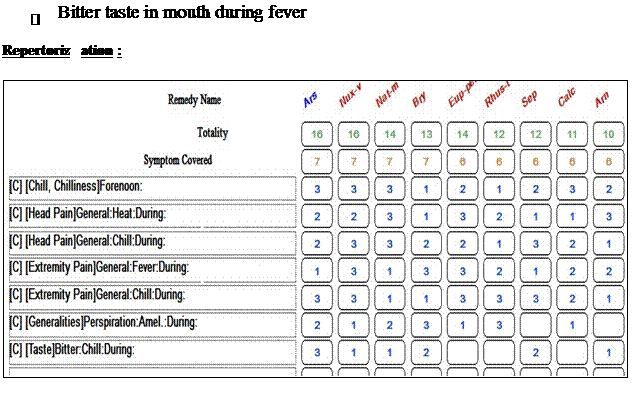
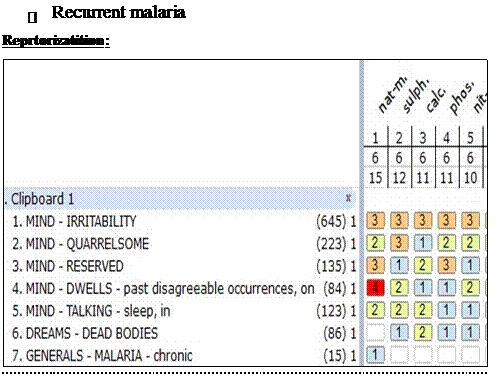
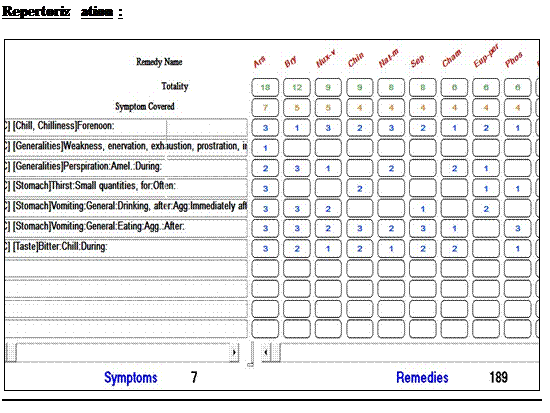
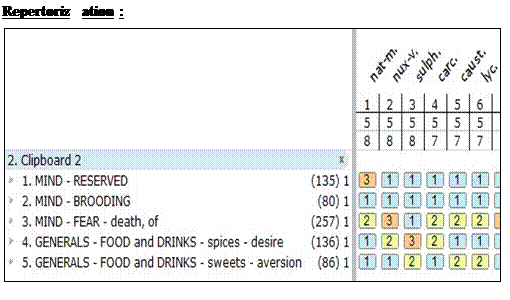
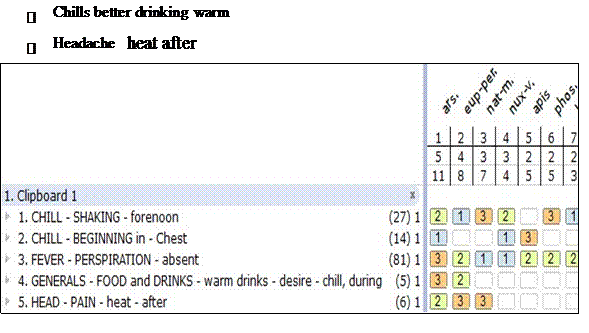
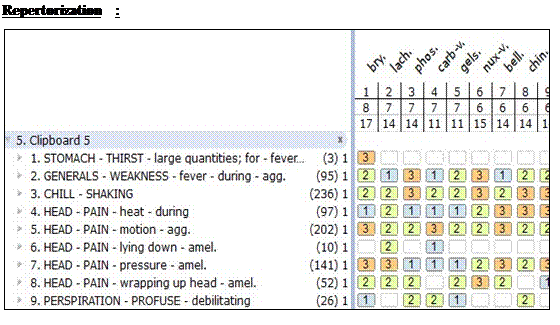
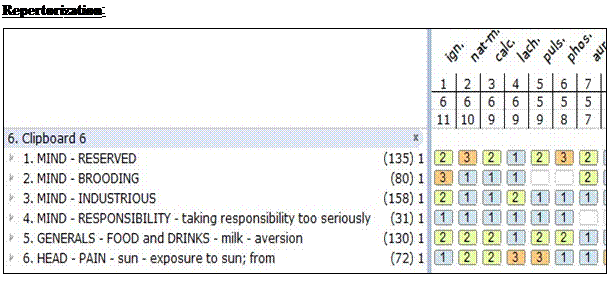
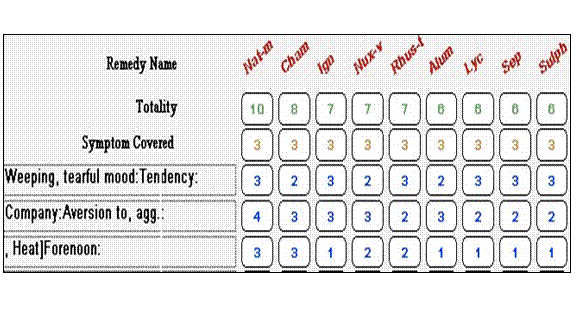
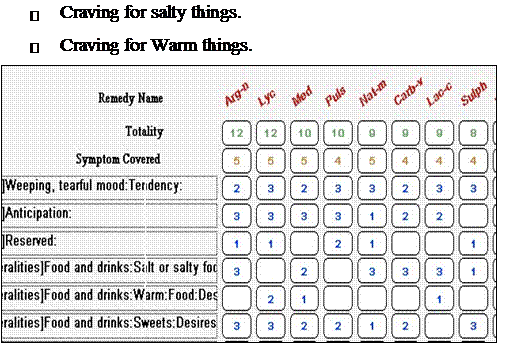
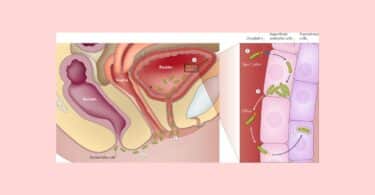
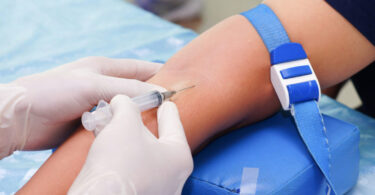
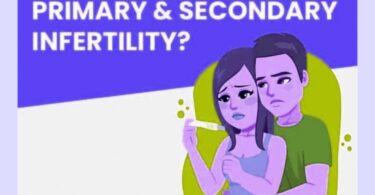
This excellent article and its accompanying cases provide many important lessons in case analysis and management, beyond the treatment of malaria.
How to protect yourself from mosquito bites ? Are there homeopathic remedies ?